Research & Reports
2021 3-Year Economic Outlook Report
Halfway through 2021, Anchorage is on a gradual climb out of the economic crater caused by COVID-19. However, employment remains thousands of jobs below pre-pandemic levels. At its worst, in April 2020, Anchorage had lost 23,000 jobs, a wrenching 15% drop. Pain was spread across the private sector but most intense in restaurants, bars, hotels, the transportation sector, other visitor-affected sectors, and personal services. The most recent data indicates employment is still about 10,000 jobs below pre-pandemic levels (down about 6%).
While it’s little consolation for the thousands of workers who lost jobs last year, it is a small blessing that total wages earned throughout Anchorage dropped only 1.3% in 2020. At this time last year, we expected COVID-19 to result in a significant decline in total personal income in Anchorage. In fact, personal income actually increased by about 3% in 2020. A billion dollar jump in transfer payments (in the form of federal COVID-19 relief payments) more than offset declining workplace earnings. In total, it was about $2 billion in federal relief funding flowing into the Anchorage economy that prevented much greater economic disaster.
Further population decline was anticipated in 2020, but the drop of 1.2% (3,517 residents) was more than double the loss expected. Anchorage’s 2020 population was estimated to be 288,970, about 12,000 below the 2013 peak of just over 301,000. Anchorage has seen population decline in six of the past seven years, with the sharpest annual drop recorded in 2020.
Another troubling trend is the shrinking labor supply in Anchorage. Labor supply (or lack thereof) could very well be what determines employment growth in Anchorage over the next few years. Anchorage has jobs to offer, but not the people to fill those jobs. Some of that is pandemic-related (including a big reduction in labor force participation among women) and some of it is related to long-term demographic shifts.
While there is plenty to worry about, there are bright spots in the economy. Independent visitor traffic has come roaring back this summer, reflecting substantial pent-up demand for tourism. Record volumes of airfreight are moving through Ted Stevens International Airport (ANC), and hundreds of millions of dollars are teed up to expand ANC’s role as a top global airfreight hub.
This three-year forecast articulates in some detail the economic damage done by the pandemic, the pace of recovery, the substantial degree of uncertainty that persists, and where long-term opportunities offer reason for optimism.



